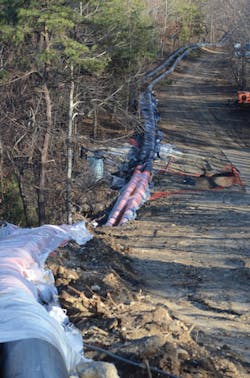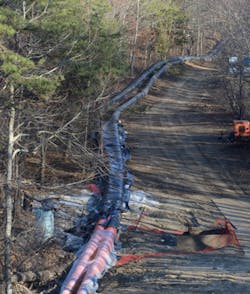No Time for Downtime
When a force main breaks in a sewer system network, it’s an immediate nightmare of epic proportions for the municipality and the utility. Such was the case for the historic Town of Plymouth, Mass., when the 4.5-mile force main from the Water Street Pump Station to the Plymouth Wastewater Treatment Plant (WWTP) gave way, six days before Christmas in December 2015.
You Do What It Takes to Get It Done
“This was a critical emergency,” said Joe Brito, Jr., president of C. Brito Construction Co. Inc. “So we needed to bring in a team that could get it done and do it right the first time. We immediately called Tom Malone, the New England branch manager at Xylem, who had delivered for us previously. We knew we were in good hands.”
The assessment by the team at 5:00 a.m. on Sunday, Dec. 20, determined there was degradation of the 30-inch force main, which had caused a break to occur approximately one mile from the WWTP.
The first step in the repair process was to mobilize what was needed for the bypass. Given the 30-inch pipe and the five to seven million gallons per day (MGD) of flow, the bypass required two lengths of 18-inch HDPE pipe run side-by-side to replace the force main and to handle the flow requirements. The length of the bypass was approximately one mile, so Xylem had to mobilize two miles of 18-inch pipe from various locations along the eastern seaboard. In addition to setting up the bypass so the break could be repaired, there was also a 6-inch line that had to be set up to move any flow that leaked from the break back to the WWTP.
Xylem Fusion Techs were at the job site and assembling pipe by late Sunday. Tractor/trailer access to the actual location of the break was not possible, so the two miles of pipe had to be fused 500 feet at a time at the work area, and then dragged through the woods and over rigorous terrain to get to the break. By 4:00 p.m. on Monday, Dec. 21, the team was able to start moving flow through the six-inch pipe from the dirty water pond at the break to the WWTP.
Continuing to fuse the 18-inch HDPE pipe around the clock over the next three days, the team was able to install the piping and make the critical connections to the existing pumps in the Plymouth network. They started pumping flow through the bypass by 5:00 a.m. Thursday - Christmas Eve. It was a welcome gift of relief to the Town of Plymouth, and a gift to the C. Brito Construction and Xylem teams to be able to be home for the holiday.
It’s worth noting that pump rental companies typically require the rental of pumps with the rental/installation of piping. However, Xylem provided pipe rental without the pump rental requirement, ultimately saving the Town of Plymouth thousands of dollars in pump-rental costs.
From Bad to Worse
The pre-Christmas bypass was executed quickly and efficiently, and it addressed the immediate need, which was to access the force main break and begin the necessary repairs as soon as possible. The C. Brito Construction team had begun the repair project, and the Xylem team had packed up by early January.
On Wednesday, Jan. 27, 2016, another call was made to Xylem. There was a second break in the force main in Plymouth, and another mile-long emergency bypass was needed. Another 10,000 feet of 18-inch HDPE, equipment, accessories, and the necessary teams were once again mobilized. The C. Brito and Xylem teams worked around the clock for four days straight, and had the second bypass online by Sunday, Jan. 31. Once all the details were in order, Malone demobilized the Xylem team and returned to Connecticut that afternoon to settle in for the evening. About 3:00 p.m., the phone rang; it was Joe Brito, Jr., with news of a third break in the force main at Plymouth.
On Monday, Feb. 1, 2016, the teams mobilized for another emergency bypass - the third in six weeks - this time for a two-mile stretch of the force main. Once again, miles of HDPE pipe, along with accessories and equipment were mobilized, and the C. Brito and Xylem teams worked around the clock to set up the bypass. It was another complex maze of aboveground piping; this time through dense residential neighborhoods.
Once and For All
On Monday, Feb. 15, once the third bypass was in place, the Town of Plymouth, C. Brito Construction and Xylem met to discuss the obvious next step: the design and implementation of a bypass for the entire 4.5-mile stretch of force main from the Water Street Pump Station to the WWTP. It was clear that the existing 30-inch force main needed to be replaced as soon as possible before another break in the pipe occurred.
“It was a phenomenal effort by all to address the emergency scenario each time,”Brito said. “The team was terrific. By the time the second and third breaks took place, back-to-back, we knew the first break wasn’t a fluke and that there were inherent issues with the entire 30-inch line. It had to be addressed immediately, as we didn’t want to risk yet another break and yet another emergency.”
On Saturday, Feb. 20, two months from the initial break and for the fourth and final time, the teams came together to implement the final bypass. This time, it was to connect the three individual bypass sections already in place into one 4.5-mile stretch from the Water Street Pump Station to the WWTP. An additional 8,000 feet of 18-inch HDPE pipe was mobilized, along with the additional equipment, accessories, and team members.
Xylem incorporated 18-inch knife valves into the bypass design so as to control flow. Four Godwin HL200 pumps were brought in to override the pumps at the Water Street Pump Station. Three electric drive pumps with variable frequency drives were installed to regulate bypass flow rate, and one critically silenced diesel pump was brought in as a redundant back-up. Flow meters from MJK, a Xylem brand, were also installed in each of the 18-inch lines, enabling further efficiencies with pump activity.
On Monday, March 7, after weeks of 24/7 emergency repair work, the teams fused the final piece of pipe, tightened the final bolts, and cranked up the Godwin HL200 pumps to push flow through the bypass, circumventing the 30-inch force main. C. Brito Construction could now begin the work in earnest to replace the failing pipe that had wreaked such havoc for nearly three months. They could now deliver to the Town of Plymouth, the utility, and the residents a solution for their sewer network that would put their minds at ease, once and for all.
As a final component of the bypass, Xylem provided 24/7 pump watch duty on site. The extra assurance that all systems were running smoothly, efficiently and without issue was a welcome bit of peace-of-mind for an already frazzled community.
By the Numbers
Plymouth, MA, Bypass Projects
50,963 - Feet of 18-inch HDPE pipe
2,856 - Hours of 24/7 pump watch duty
1,982 - Field service man hours for set up and pipe fusion
11 - Weeks from first force main break to completion of final bypass
87 - Truckloads of pipe, equipment, and accessories delivered to the site
10 - States and Canada, from where the pipe, equipment, and accessories were mobilized; as far away as Florida and Ohio
3 - Pipe breaks needing emergency bypass
1 - Final bypass, connecting 3 temporary sections and ultimately spanning 4.5 miles





